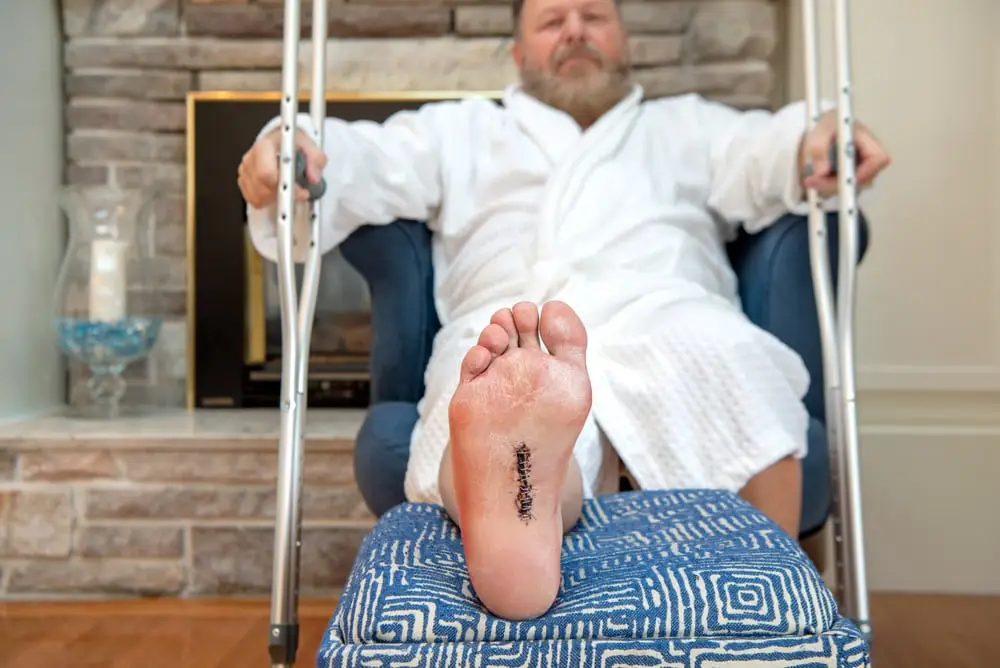
Are you considering plantar fibroma surgery?
Fibromas are a benign growth of fibrous tissue that can develop in various parts of the body. Fibroma is classified as a hyperproliferation of fibrous tissue. They may occur in the uterus or in places like the hand as examples. When this occurs on the palm of the hand, they are called dupuytren’s contracture. Fibroma can also occur in the arch of the foot and is referred to as plantar fibromatosis. The growth itself is within the plantar fascia. Plantar fibroma surgery is not our recommended treatment method, we will discuss the pros and cons to help one decide.
Until recently, the treatment options were very minimal. For many, surgery was considered a way to get rid of the growth. Options such as cortisone injections and the use of ultrasound physical therapy may have some effect, but tend to not provide significant long-term benefits.
![]()
Plantar Fibroma Surgery
When plantar fibroma surgery is performed There are two approaches:
- Removal of the growth through includes a small incision localized to the area around the growth. This may include removal of a small portion of the plantar fascia around the growth.
- Removal of the entire plantar fascia through an incision that extends the entire length of the foot.
- The more aggressive approach using a long incision and removal of the fascia is most successful, but still results in a 25 percent recurrence rate.
Recovery
The recovery from this surgery requires the patient to remain non weight bearing for 3 weeks. This is to avoid the creation of a painful scar on the bottom of the foot. Besides the potential for a painful scar, recurrence and potential for nerve damage may be other potential risks.
Our Preferred Non-Surgical Solution to Ledderhose Disease
We have had great success using a series of injections to reduce and eliminate plantar fibromas from your foot. This treatment option was pioneered by a colleague of mine, Dr.Ed Davis, who originated the concept 1 . The process involves a series of three injections into the tumor.
Before the procedure is performed, the plantar fibromatosis is measured using diagnostic ultrasound. Ultrasound is also used to guide the needle into the tumor. A combination of local anesthetic, cortisone, and enzyme solution are used to break down the tissue.
Recovery
Patients are able to walk immediately with minimal layup. Most can return to full activity in 2 days. At first, the plantar fibromatosis becomes soft, followed by reduction in size with each subsequent treatment. Although three treatments at 2-to-three-week intervals may be enough for many, a fourth and fifth injection may be necessary. For many, this may complete the treatment with no recurrence; however, if an occurrence occurs, and is caught early before the tumor becomes too large, fewer injections are needed.
Risks of Plantar Fibroma Surgery vs Injections
These injections have little to no risk compared to surgery, and have a higher success rate. This treatment option has become the standard at Anderson Podiatry Center. For many it has been very gratifying to discover that finally they may have a non-surgical option for this difficult problem.
Consider this new option when it hurts to walk from your plantar fibromatosis. It’s a low-risk process with a high percentage of success. Don’t lose hope and throw in the towel if you have this aggravating problem. This is a new option that you should consider! We are conveniently located at Fort Collins and Broomfield should you wish to book an appointment with one of our podiatrist.
For patients outside colorado there is information on planning a visit on our patient resources section.
References
1 Occtober 25, 2018. Dr. Ed Davis. Ledder Hose Disease. https://www.ledderhosedisease.com/about/


